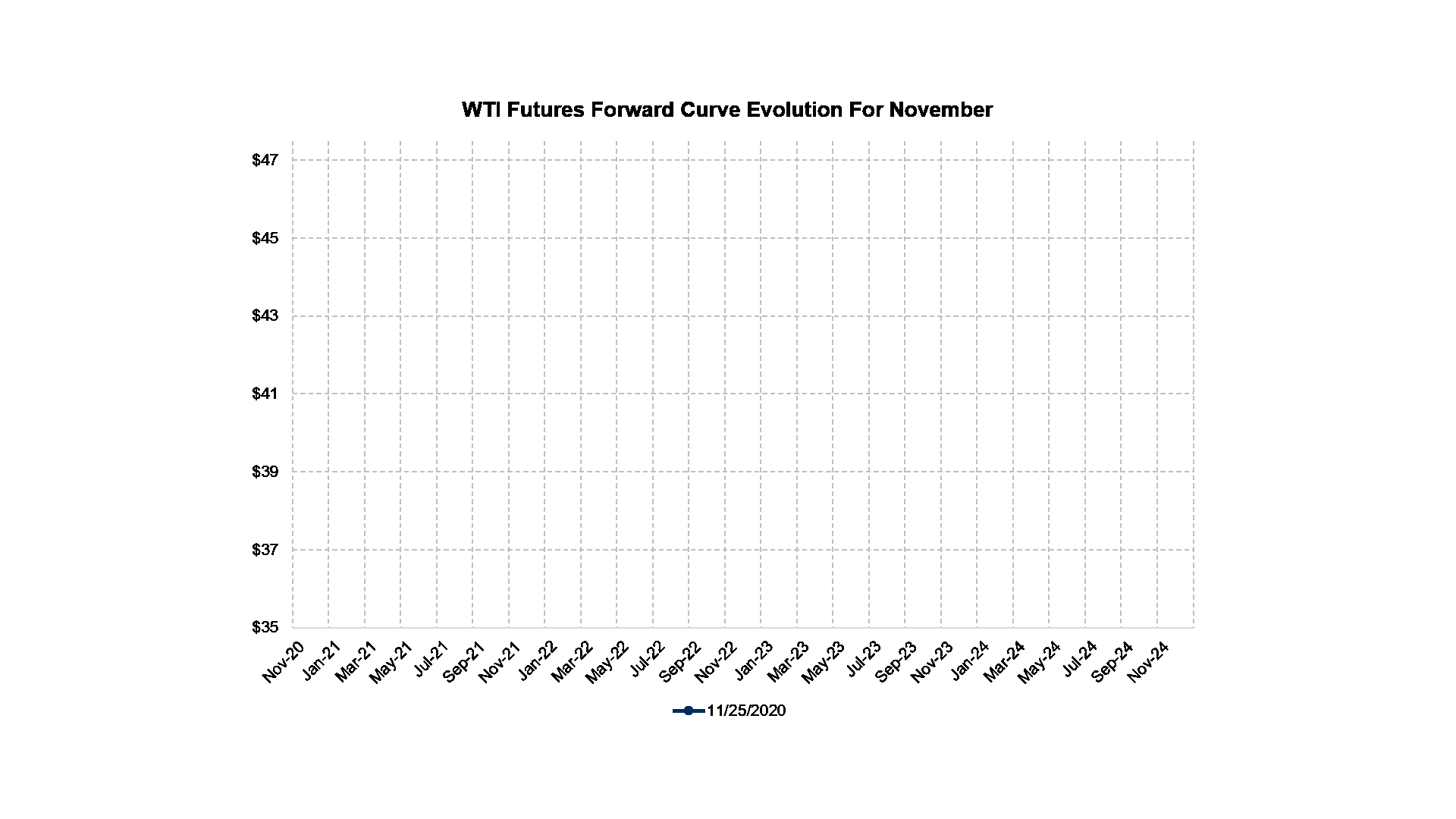Crude prices have shot higher this month as multiple companies have announced breakthrough results with their COVID-19 vaccine. News that vaccines will reach populations quicker than previously thought could positively impact demand for parts of 2021. In addition to vaccine news, OPEC+ is signaling that it will delay a decision to return 2 MMBbl/d to the market in January as it has previously planned. Rhetoric from the group suggests that the curtailments will be extended by three to six months. The group will meet virtually on Nov. 30-Dec. 1 to make an official decision on this policy change.
 As bullish news encouraged buying, and oil prices moved higher, The WTI curve has moved into backwardation (a downward slope) starting in the March 2021 forward tenor. More near-term futures remain in contango, or upward sloping. The recent curve is much different compared to late October's curves, when contango persisted in the entire forward curve.
Why have portions of the curve moved into backwardation? Usually, backwardation implies that the physical market is tight or demand outweighs supply. If there were a shortage of barrels in the physical market, then consumers would bid near-term prices higher, leading to a downward-sloping forward curve. But the most recent backwardation has been concentrated not in the front of the curve, but rather during the middle part of 2021. This "delayed" backwardation could be explained by a combination of anticipated global supply reductions, mostly from OPEC+, and more positive sentiment for demand later in 2021 due to vaccine news. Oil market participants may think that 2H2021 will be much tighter and will incentivize pulls on global oil storage, therefore raising more near-term oil prices.
Another contributor to the twist in curve shape could be that producers are hedging volumes in 2021 and 2022 rather than the front of the curve. Oil and gas companies are likely setting budgets and planning for 2021 operations. The recent rise in oil prices across the curve has given them an opportunity to lock-in prices not seen in some time. Producers, by nature, initiate the selling of forward contracts, so if there is enough volume in certain tenors, the curve dips lower where most of the selling is concentrated.Despite the rally and strengthening curve, AEGIS still urges caution on oil prices through mid-2021. The recent rally is an opportunity to establish more, higher priced hedges. Higher prices are welcome, but coronavirus cases continue to escalate, and lockdowns still pose a threat to demand. The OPEC+ response is not certain. We remain bullish for late-2021 (and beyond) after vaccines could be distributed to the general population.
As bullish news encouraged buying, and oil prices moved higher, The WTI curve has moved into backwardation (a downward slope) starting in the March 2021 forward tenor. More near-term futures remain in contango, or upward sloping. The recent curve is much different compared to late October's curves, when contango persisted in the entire forward curve.
Why have portions of the curve moved into backwardation? Usually, backwardation implies that the physical market is tight or demand outweighs supply. If there were a shortage of barrels in the physical market, then consumers would bid near-term prices higher, leading to a downward-sloping forward curve. But the most recent backwardation has been concentrated not in the front of the curve, but rather during the middle part of 2021. This "delayed" backwardation could be explained by a combination of anticipated global supply reductions, mostly from OPEC+, and more positive sentiment for demand later in 2021 due to vaccine news. Oil market participants may think that 2H2021 will be much tighter and will incentivize pulls on global oil storage, therefore raising more near-term oil prices.
Another contributor to the twist in curve shape could be that producers are hedging volumes in 2021 and 2022 rather than the front of the curve. Oil and gas companies are likely setting budgets and planning for 2021 operations. The recent rise in oil prices across the curve has given them an opportunity to lock-in prices not seen in some time. Producers, by nature, initiate the selling of forward contracts, so if there is enough volume in certain tenors, the curve dips lower where most of the selling is concentrated.Despite the rally and strengthening curve, AEGIS still urges caution on oil prices through mid-2021. The recent rally is an opportunity to establish more, higher priced hedges. Higher prices are welcome, but coronavirus cases continue to escalate, and lockdowns still pose a threat to demand. The OPEC+ response is not certain. We remain bullish for late-2021 (and beyond) after vaccines could be distributed to the general population.